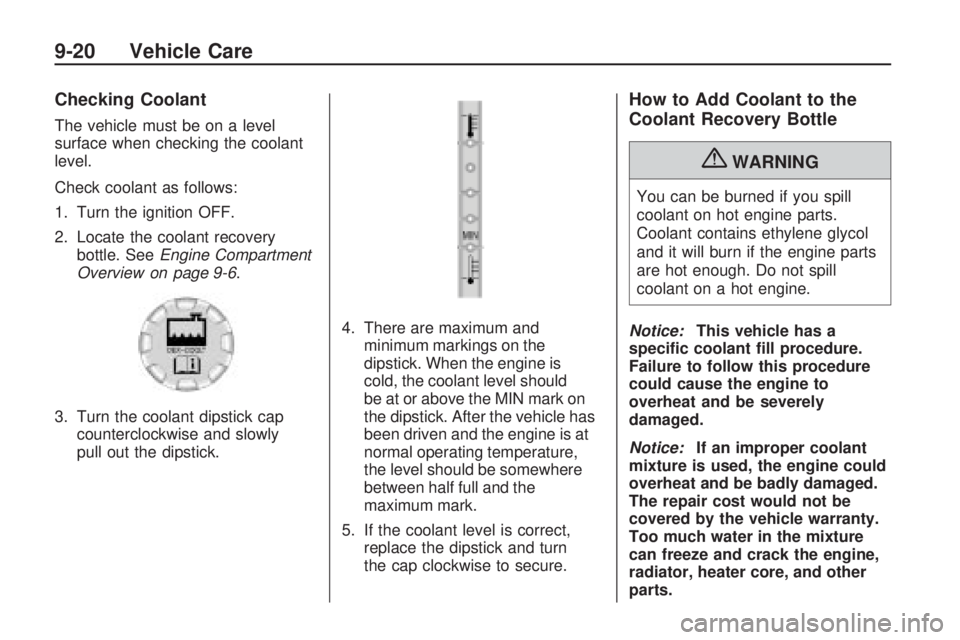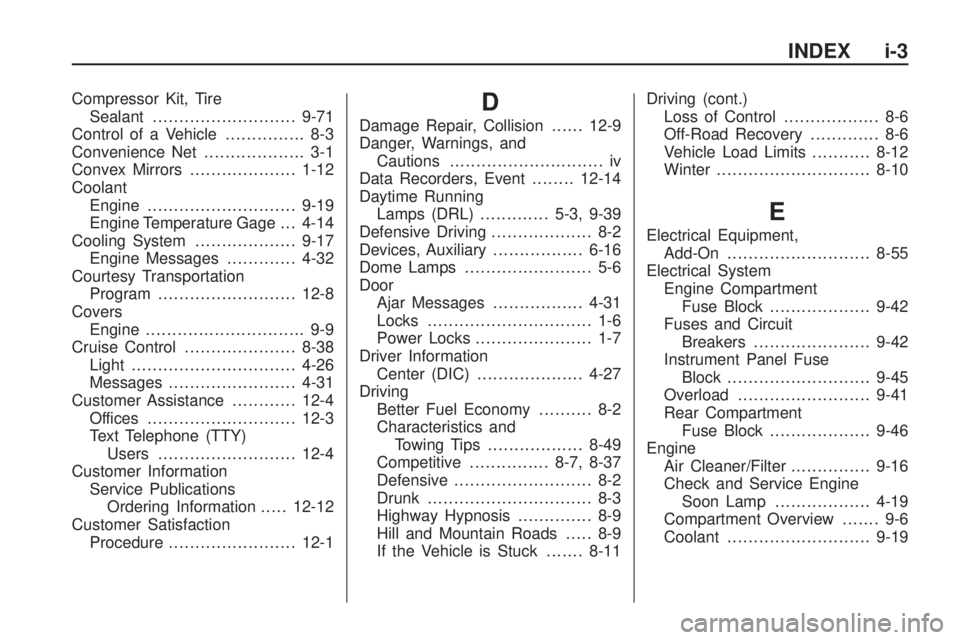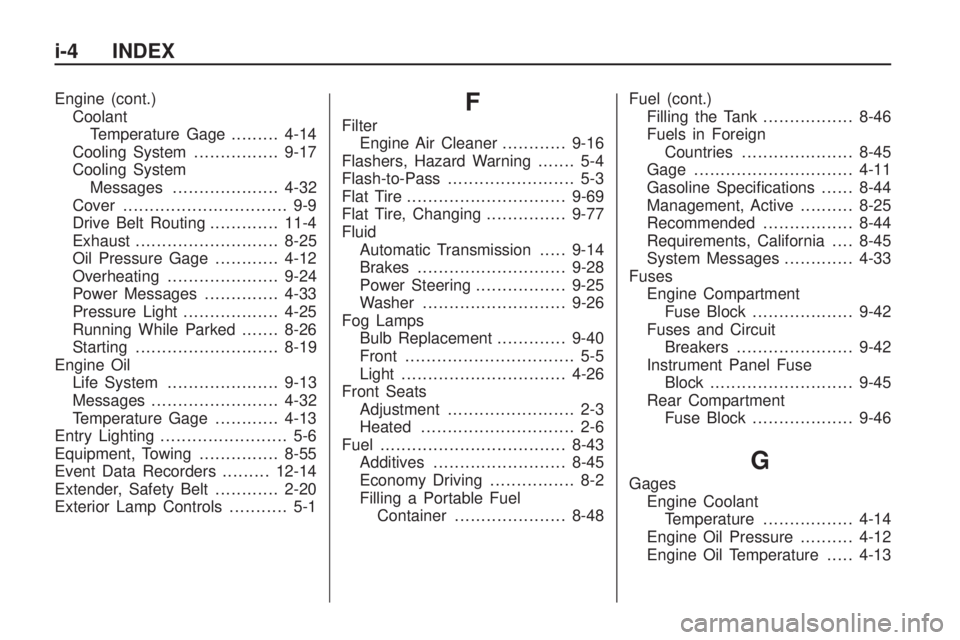coolant temperature CHEVROLET CAMARO SS 2010 User Guide
[x] Cancel search | Manufacturer: CHEVROLET, Model Year: 2010, Model line: CAMARO SS, Model: CHEVROLET CAMARO SS 2010Pages: 372, PDF Size: 1.91 MB
Page 252 of 372

Checking Coolant
The vehicle must be on a level
surface when checking the coolant
level.
Check coolant as follows:
1. Turn the ignition OFF.
2. Locate the coolant recovery
bottle. SeeEngine Compartment
Overview on page 9-6.
3. Turn the coolant dipstick cap
counterclockwise and slowly
pull out the dipstick.4. There are maximum and
minimum markings on the
dipstick. When the engine is
cold, the coolant level should
be at or above the MIN mark on
the dipstick. After the vehicle has
been driven and the engine is at
normal operating temperature,
the level should be somewhere
between half full and the
maximum mark.
5. If the coolant level is correct,
replace the dipstick and turn
the cap clockwise to secure.
How to Add Coolant to the
Coolant Recovery Bottle
{WARNING
You can be burned if you spill
coolant on hot engine parts.
Coolant contains ethylene glycol
and it will burn if the engine parts
are hot enough. Do not spill
coolant on a hot engine.
Notice:This vehicle has a
speci�c coolant �ll procedure.
Failure to follow this procedure
could cause the engine to
overheat and be severely
damaged.
Notice:If an improper coolant
mixture is used, the engine could
overheat and be badly damaged.
The repair cost would not be
covered by the vehicle warranty.
Too much water in the mixture
can freeze and crack the engine,
radiator, heater core, and other
parts.
9-20 Vehicle Care
Page 256 of 372

Engine Overheating
The vehicle has an indicator to warn
of engine overheating.
There is an engine coolant
temperature warning light on
your vehicle’s instrument panel.
SeeEngine Coolant Temperature
Gage on page 4-14.
You may decide not to lift the hood
when this warning appears, but
instead get service help right away.
SeeRoadside Assistance Program
on page 12-6.
If you do decide to lift the hood,
make sure the vehicle is parked
on a level surface.Then check to see if the engine
cooling fans are running. If the
engine is overheating, both fans
should be running. If they are
not, do not continue to run the
engine and have the vehicle
serviced.
Notice:Engine damage from
running the engine without
coolant is not covered by the
warranty.
Notice:If the engine catches
�re because of being driven with
no coolant, your vehicle can be
badly damaged. The costly repairs
would not be covered by the
vehicle warranty.
If Steam Is Coming From The
Engine Compartment
{WARNING
Steam from an overheated engine
can burn you badly, even if you
just open the hood. Stay away
from the engine if you see or hear
steam coming from it. Just turn it
off and get everyone away from
the vehicle until it cools down. Wait
until there is no sign of steam or
coolant before you open the hood.
If you keep driving when your
engine is overheated, the liquids
in it can catch fire. You or others
could be badly burned. Stop your
engine if it overheats, and get out
of the vehicle until the engine
is cool.
9-24 Vehicle Care
Page 363 of 372

Compressor Kit, Tire
Sealant...........................9-71
Control of a Vehicle............... 8-3
Convenience Net................... 3-1
Convex Mirrors....................1-12
Coolant
Engine............................9-19
Engine Temperature Gage . . . 4-14
Cooling System...................9-17
Engine Messages.............4-32
Courtesy Transportation
Program..........................12-8
Covers
Engine.............................. 9-9
Cruise Control.....................8-38
Light...............................4-26
Messages........................4-31
Customer Assistance............12-4
Offices............................12-3
Text Telephone (TTY)
Users..........................12-4
Customer Information
Service Publications
Ordering Information.....12-12
Customer Satisfaction
Procedure........................12-1D
Damage Repair, Collision......12-9
Danger, Warnings, and
Cautions............................. iv
Data Recorders, Event........12-14
Daytime Running
Lamps (DRL) .............5-3, 9-39
Defensive Driving................... 8-2
Devices, Auxiliary.................6-16
Dome Lamps ........................ 5-6
Door
Ajar Messages.................4-31
Locks............................... 1-6
Power Locks...................... 1-7
Driver Information
Center (DIC)....................4-27
Driving
Better Fuel Economy.......... 8-2
Characteristics and
Towing Tips ..................8-49
Competitive...............8-7, 8-37
Defensive.......................... 8-2
Drunk............................... 8-3
Highway Hypnosis.............. 8-9
Hill and Mountain Roads..... 8-9
If the Vehicle is Stuck.......8-11Driving (cont.)
Loss of Control.................. 8-6
Off-Road Recovery............. 8-6
Vehicle Load Limits...........8-12
Winter.............................8-10
E
Electrical Equipment,
Add-On...........................8-55
Electrical System
Engine Compartment
Fuse Block...................9-42
Fuses and Circuit
Breakers......................9-42
Instrument Panel Fuse
Block...........................9-45
Overload.........................9-41
Rear Compartment
Fuse Block...................9-46
Engine
Air Cleaner/Filter...............9-16
Check and Service Engine
Soon Lamp..................4-19
Compartment Overview....... 9-6
Coolant...........................9-19
INDEX i-3
Page 364 of 372

Engine (cont.)
Coolant
Temperature Gage.........4-14
Cooling System................9-17
Cooling System
Messages....................4-32
Cover............................... 9-9
Drive Belt Routing.............11-4
Exhaust...........................8-25
Oil Pressure Gage............4-12
Overheating.....................9-24
Power Messages..............4-33
Pressure Light..................4-25
Running While Parked.......8-26
Starting...........................8-19
Engine Oil
Life System.....................9-13
Messages........................4-32
Temperature Gage............4-13
Entry Lighting........................ 5-6
Equipment, Towing...............8-55
Event Data Recorders.........12-14
Extender, Safety Belt............2-20
Exterior Lamp Controls........... 5-1F
Filter
Engine Air Cleaner............9-16
Flashers, Hazard Warning....... 5-4
Flash-to-Pass........................ 5-3
Flat Tire..............................9-69
Flat Tire, Changing...............9-77
Fluid
Automatic Transmission.....9-14
Brakes............................9-28
Power Steering.................9-25
Washer...........................9-26
Fog Lamps
Bulb Replacement.............9-40
Front................................ 5-5
Light...............................4-26
Front Seats
Adjustment........................ 2-3
Heated............................. 2-6
Fuel...................................8-43
Additives.........................8-45
Economy Driving................ 8-2
Filling a Portable Fuel
Container.....................8-48Fuel (cont.)
Filling the Tank.................8-46
Fuels in Foreign
Countries.....................8-45
Gage ..............................4-11
Gasoline Specifications......8-44
Management, Active..........8-25
Recommended.................8-44
Requirements, California....8-45
System Messages.............4-33
Fuses
Engine Compartment
Fuse Block...................9-42
Fuses and Circuit
Breakers......................9-42
Instrument Panel Fuse
Block...........................9-45
Rear Compartment
Fuse Block...................9-46
G
Gages
Engine Coolant
Temperature.................4-14
Engine Oil Pressure..........4-12
Engine Oil Temperature.....4-13
i-4 INDEX